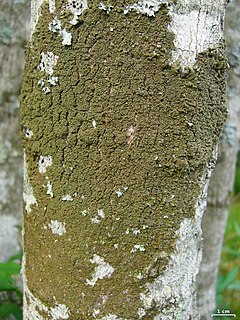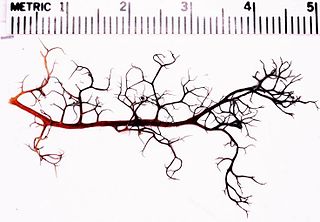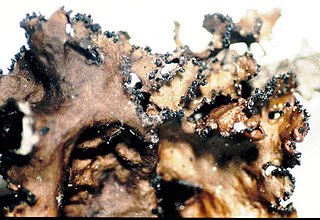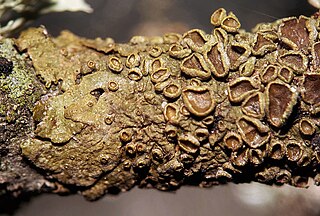
Usnea is a genus of mostly pale grayish-green fruticose lichens that grow like leafless mini-shrubs or tassels anchored on bark or twigs. The genus is in the family Parmeliaceae. It grows all over the world. Members of the genus are commonly called old man's beard, beard lichen, or beard moss.

The Parmeliaceae is a large and diverse family of Lecanoromycetes. With over 2700 species in 71 genera, it is the largest family of lichen-forming fungi. The most speciose genera in the family are the well-known groups: Xanthoparmelia, Usnea, Parmotrema, and Hypotrachyna.

Pseudephebe is a genus of fruticose lichens in the family Parmeliaceae. It contains three species that grow on rocks.

Hypogymnia is a genus of foliose lichens in the family Parmeliaceae. They are commonly known as tube lichens, bone lichens, or pillow lichens. Most species lack rhizines that are otherwise common in members of the Parmeliaceae, and have swollen lobes that are usually hollow. The lichens usually grow on the bark and wood of coniferous trees.

Melanohalea is a genus of foliose lichens in the family Parmeliaceae. It contains 30 mostly Northern Hemisphere species that grow on bark or on wood. The genus is characterized by the presence of pseudocyphellae, usually on warts or on the tips of isidia, a non-pored epicortex, and a medulla containing depsidones or lacking secondary compounds. Melanohalea was circumscribed in 2004 as a segregate of the morphologically similar genus Melanelia.

Melanelixia is a genus of foliose lichens in the family Parmeliaceae. It contains 15 Northern Hemisphere species that grow on bark or on wood. The genus is characterized by a pored or fenestrate epicortex, and the production of lecanoric acid as the primary chemical constituent of the medulla. Melanelixia was circumscribed in 2004 as a segregate of the related genus Melanelia.

Parmotrema is a genus of lichen belonging to the family Parmeliaceae. It is a large genus, containing an estimated 300 species, with a centre of diversity in subtropical regions of South America and the Pacific Islands.

Gowardia is a genus of medium-sized, greyish hair lichens in the family Parmeliaceae. It is a circumpolar genus, mainly restricted to arctic-alpine habitats in northern Canada, Europe, and Russia.

Tuckermanella is a genus of lichen-forming fungi in the family Parmeliaceae.

Bryoria is a genus of lichenized fungi in the family Parmeliaceae. Many members of this genus are known as horsehair lichens. The genus has a widespread distribution, especially in boreal and cool temperate areas.
Melanohalea zopheroa is a species of lichen in the family Parmeliaceae. It was first formally described in 1977 by Ted Esslinger as Parmelia zopheroa. A year later, he transferred it to the new genus Melanelia, which he created to contain the brown Parmeliae species. In 2004, after early molecular phylogenetic evidence showed that Melanelia was not monophyletic, Melanohalea was circumscribed by lichenologists Oscar Blanco, Ana Crespo, Pradeep K. Divakar, Esslinger, David L. Hawksworth and H. Thorsten Lumbsch, and M. zopheroa was transferred to it. The lichen has a disjunct distribution, as it is found in South America (Chile) and in New Zealand.
Melanohalea ushuaiensis is a species of lichen in the family Parmeliaceae. It was first formally described in 1917 by Alexander Zahlbruckner as Parmelia ushuaiensis. Ted Esslinger transferred to the new genus Melanelia in 1978, which he circumscribed to contain the brown parmeliae species. In 2004, it was moved to the newly created genus Melanohalea. It is endemic to South America.

Melanohalea subolivacea, commonly known as the brown-eyed camouflage lichen, is a species of foliose lichen in the family Parmeliaceae.

Melanohalea subelegantula is a species of lichen in the family Parmeliaceae. It is found in North America, where it grows on bark and wood. The lichen was first formally described as Parmelia subelegantula by Ted Esslinger in 1977. A year later he transferred it to the segregate genus Melanelia. In 2004, it was moved to the newly circumscribed genus Melanohalea. Named for its resemblance to Melanohalea elegantula, it can be distinguished from that species by its slightly flattened, but not hollow, isidia.

Melanohalea elegantula, commonly known as the elegant camouflage lichen, is a species of lichen in the family Parmeliaceae. It was first described by Alexander Zahlbruckner in 1894 as Parmelia aspidota var. elegantula. Hungarian lichenologist Ödön Szatala promoted it to full species status, as Parmelia elegantula, in 1930. Ted Esslinger transferred it to the genus Melanelia in 1978. Finally, it was assigned to the newly circumscribed genus Melanohalea in 2004.

Pseudephebe minuscula is a species of fruticose lichen in the family Parmeliaceae. In North America, it is known colloquially as coarse rockwool. It has an antitropical distribution.

Gowardia nigricans, commonly known as the gray hair lichen or gray witch's hair, is a species of fruticose lichen in the family Parmeliaceae.
















